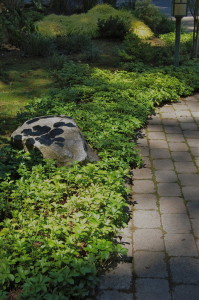 Evergreen ground cover has endless uses, from serving as a lawn substitute to creating a green cascade on a wooded hillside. During summer ground cover can create a soft backdrop for other plants; during wintertime it becomes a primary part of the garden while other plants are dormant or without leaves. Whether a lush accent at the base of a tree or planted en masse to form a carpet, evergreen ground cover provides a visual break from bare soil and dark sky.
Evergreen ground cover has endless uses, from serving as a lawn substitute to creating a green cascade on a wooded hillside. During summer ground cover can create a soft backdrop for other plants; during wintertime it becomes a primary part of the garden while other plants are dormant or without leaves. Whether a lush accent at the base of a tree or planted en masse to form a carpet, evergreen ground cover provides a visual break from bare soil and dark sky.
Easy-to-grow ground covers
Some steppable ground covers, especially those that thrive in full sun, like the famous Woolly Thyme, are not picky about soil conditions and need little water. But most ground cover plants used as part of a garden plan need ideal conditions to grow vigorously, spread and fill in. For instance, Pachysandra terminalis (pictured) thrives in shade, but also needs fertile soil and some water to grow well. With glossy green leaves, it forms a 6-inch high pillow on top of the ground with surface roots that need rich soil to do well. Its green stems and shiny leaves create an interesting texture that draws the eye. Gaultheria procumbens also looks handsome at this time of year with its red berries and glossy dark green leaves. Note that, come spring and summer, most hardy bulbs and perennials will grow up through ground cover.
Containing and maintaining ground covers
When selecting ground cover, beware of invasive plants that are hard to control. Invasive ground covers typically tolerate poor soil conditions, which is why they are so tempting to plant in problem areas of the garden. They can, in fact, be an asset in large shady areas like a woodland garden where they will fill in at the base of trees where little else may grow. The less-aggressive Vinca ‘Illumination” has stunning golden variegation, making it a real standout in the landscape .
But be prepared. The more invasive ground covers must be carefully selected and completely contained. Once a ground cover gets away from you, you face an on going battle to keep it at bay. Even favorites like Vinca minor can easily overstay its welcome. Once its roots are entangled with other plants or a rockery, it can only be controlled with continuous maintenance.
Properly selected and maintained, ground cover can play an important role in your landscape. Check your garden this winter and see if you have any bare spots that would benefit from ground cover.
Contact us to learn more about garden planning, landscape design, and fall planting.
